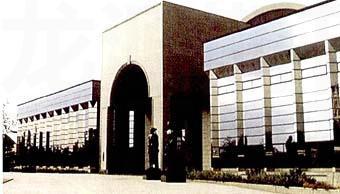The Mystery of a Gold Seal
2009-05-31ShaZhou
Sha Zhou

A white sand beach stretches several kilometers northeast of Hakata, Japan, flanked by a verdant pine forest which stands against waves and winds. The beach is one of the best holiday resorts in Hakata.
If you walk along the beach you will soon arrive at Shikanoshima, a peninsular jutting out into the sea. The scenic place enjoys a fame in Japan and East Asia for its propinquity to Pusan of Korea and its picturesque seascape if you look westward into the depth of the ocean. It is also renowned for the gold seal discovered accidentally by a farmer in February, 1784. As story goes, a local farmer, while preparing an irritation ditch for the upcoming spring, dug into a stone cavity covered by a huge stone. He found a piece of metal glittering underneath. He brought it to a local rice shop owner. The owner congratulated the farmer on his good fortune, for it was an ancient gold seal. The villager immediately turned the seal to the government. After studying the seal and the five Chinese characters carved on it, a famous Confucius scholar of Japan concluded that the five characters were 汉委奴国王 and that the seal was granted by Emperor Guangwu of the Han Dynasty (206 B.C.-220 A.D.) to the king of the Na state of Wa (vassal) of the Han Dynasty.
Chinese history chronicles contacts and ties between China and Japan in very ancient times. For example, the “Geographical Records” in “The History of the Han Dynasty” states that there were the Wa people in the sea of Korea. Wa is an ancient name Chinese used to describe Japan of that time. During that time, the Wa people were divided into more than a hundred of states. They often sent attributes to the Han Dynasty and China gave them generous gifts in return. “The History of Later Han Dynasty” describes the lifestyle of Japan and records that in 57 A.D., the Chinese emperor granted a gold seal to the king of the Na State. The gold seal is not the only material evidence that testifies to the relations between China and Japan about 2,000 years ago. Bronze mirrors, and jade pieces made in Chinas Western Han Dynasty (206BC-8AD) have been unearthed in Honshu and Kyushu, two major islands of Japan.
During the following 200 years, there was controversy over the gold seal. Was it really the one bestowed by Emperor Guangwu of the Han Dynasty? Chinese and Japanese archaeologists and historians have conducted thorough studies in various fields and have concluded that the seal was indeed the one bestowed by the said Chinese emperor. The five Chinese characters are unmistakable evidence. The size of the seal is right if the measurement system of the Han Dynasty is taken into account. The protocol system of the Han Dynasty stipulated that the size of a seal for a vassal state should be no more than 1 square inch, roughly equal to the 2.43 square centimeters of the gold seal found in Shikanoshima. In China, similar gold seals of the Han Dynasty were found in Yunnan in 1956 and in Jiangsu in 1981. They belonged to vassal states of the Han Dynasty and are similar in terms of size, calligraphic style, shape of the gold seal unearthed in Shikanoshima.
Studies show why the gold seal was buried. The Na State declined as the Yamatai State rose and ruled the Japanese islands. After the Eastern Han Dynasty was replaced by the Wei State, Yamatai sent messengers to China and established ties with China. The Japanese messengers brought back many gifts including 100 bronze mirrors. The ruler of the Na State had to secretly bury the gold seal which signified power and the support of the Han Dynasty of China.
The discovery of the gold seal is the material evidence of the ties between China and Japan during the Han Dynasty. The site where the gold seal was discovered is now a park in memory of the historic seal. A tall stone pillar stands at the entrance to the park, signifying the place where the Han seal bestowed to the Na state was unearthed. The explanation was written in Chinese characters, which were used in Japan for more than a thousand of years and are still in use today. A stone path leads to the very spot where the gold seal was unearthed. At the center of the spot stands a square stele in memory of the discovery. Beside the stele is a stone monument carved with an inscription by former Chinese president Yang Shangkun. Nearby is a stele carved with a poem by Guo Moruo, a modern Chinese scholar.□
